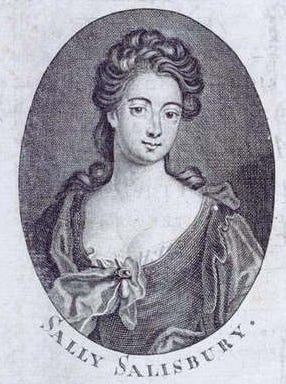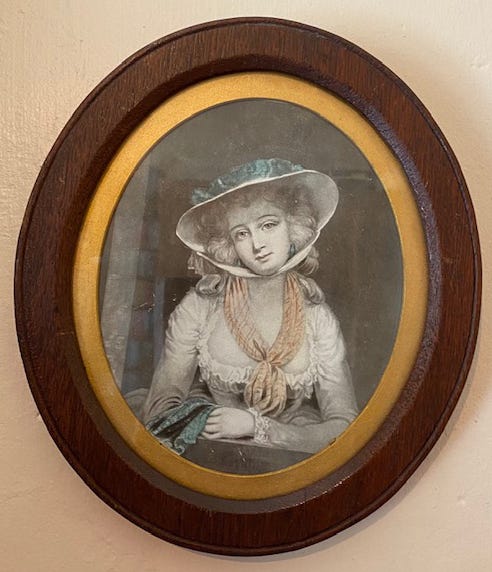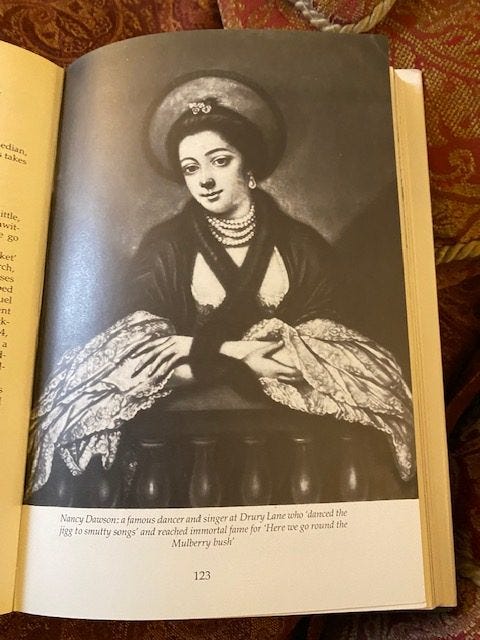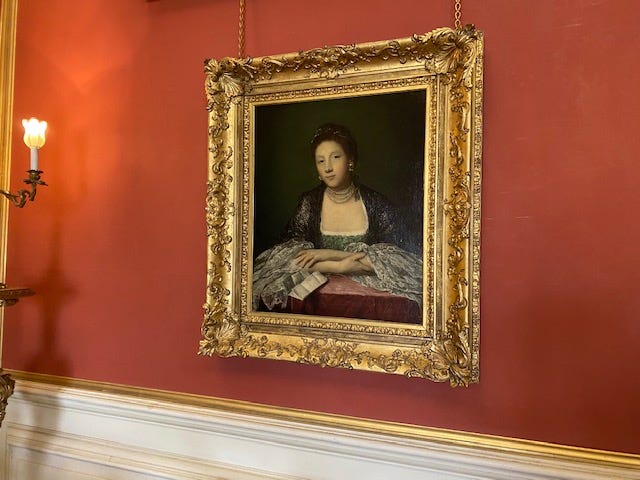I have been living with this portrait of an unknown woman (above) for a while now. She hangs on the wall of our office at home, above the printer, gazing softly down at me as I type. Her manner is unmistakeably sentimental, and though the print may well be 19th century, the subject probably dates from the 1780s, judging from her hairstyle and the demure hat tied under her chin.
As soon as I saw the picture, it reminded me of another print: a portrait of Nancy Dawson which I had first encountered in E. J. Burford’s Wits, Wenchers and Wantons (an excellent book if you want to know about the sex trade around Covent Garden in the 18th century). Dawson’s portrait is pretty much the opposite of demure. According to Burford, Dawson was a “little, vulgar comic actress” who popularised the song ‘Here we go round the Mulberry Bush’.
Intrigued at the similarities between the unknown lady’s scarf, crossed across her breast, and Dawson’s much more provocative version, I turned to A Biographical Dictionary of Actors and Actresses and found the same picture of Dawson reproduced there (vol. 4, p. 237). As the Dictionary tells us, Dawson was born around 1730 and started her career as a dancer at Sadler’s Wells in London. She pitched up at Covent Garden in 1758 as a dancer in a revival of Betterton’s dramatic opera, The Prophetess. However, she was mostly known for dancing a hornpipe to ‘The Ballad of Nancy Dawson’ (the tune which we now know as ‘Here we go round the Mulberry Bush’). She was also the subject of a dubious and probably fictionalised pamphlet called Authentic Memoirs of the Celebrated Miss Nancy D-ws-n, published around 1761. She died at Haverstock Hill on June 9th 1767.
Could these two portraits have anything in common? Over the last few years, while writing a biography of the 18th-century actress Peg Woffington, I’ve frequently grappled with the notion of sexual celebrity. Theatrical celebrity (as opposed to the more heroic ‘fame’) was a new concept in the 18th century and, by the 1750s, collided with a trend for reading about the lives of prostitutes and courtesans.
Faramerz Dabhoiwala has written in The Origins of Sex about the phenomenon of sexual celebrity which he calls “one of the most striking novelties of eighteenth-century culture”. Around 1700, he tells us, the idea that the public would be fascinated with the lives of low-born whores was unthinkable, but as the century progressed – and a greater stress was placed on the passivity of respectable women – a whole culture grew up around their ‘immoral’ counterparts. “Their actions were routinely reported in newspapers and magazines,” writes Dabhoiwala, “their personalities analysed in pamphlets and poems, their portraits painted, engraved, and caricatured.”
Part of the reason for this was the explosion in the markets for both print and portraiture in 18th-century Britain. Dawson’s Authentic Memoirs fed into the appetite for ‘true’ stories of real women – stories which would later help to define a new genre: pornography. But the availability of cheap prints (and fashionable techniques such as mezzotint) also fanned the flames of sexual celebrity.
Dawson’s popularity was prefigured by Sally Salisbury’s: a sex-worker whose notoriety grew in the 1720s after she attacked her lover, the Hon. John Finch, with a knife. Several of Salisbury’s biographies included portraits that hinted at her sexual availability (later, the poet Henry Carey complained that his innocent ballad ‘Sally in our Alley’ was thought to be an ode to Salisbury). By mid-century, courtesans like Fanny Murray and Kitty Fisher were not only household names but the subject of formal portraiture by establishment figures.

An interesting quality of the 18th-century courtesan portrait is its interchangeability. In her biography of Fanny Murray, Barbara White reproduces identical prints captioned with Murray and Fisher’s names. The popularity of these two courtesans reached its height in the 1750s and 1760s.
However, a portrait of Fisher by Sir Joshua Reynolds (below) appears to have been the source for the cross-armed pose in both my portrait and the one of Nancy Dawson (whose popularity on-stage was growing around the late 1750s). I have known this portrait for years, but I came across it in ‘real life’ the other day on a trip to Petworth House in West Sussex. It was like seeing an old friend. Note that the sleeves are of abundant lace, but the pose is pretty much the same.
(There is a clearer view of it on the Petworth House website here.)
Then, a few weeks later, I visited the Holburne Museum in Bath. High up on one of the gallery walls was a Fisher ‘clone’ (below), in other words, a painting of Mrs Frances Holburne with the familiar décolletage and big sleeves. It was described as ‘School of Sir Joshua Reynolds’ and painted in 1760. Here we have Frances – a respectable lady – copying Fisher at the height of the courtesan craze.
(You can see this painting on the Holburne’s website here.)
By the 1780s (roughly when my portrait was created), times were changing. Sensibility was a new watchword, and the middling sort were rejecting the brazenness of earlier decades. But don’t be fooled by the dreamy eyes and sweetly cocked head of my mystery lady. Behind her decorous appearance drifts the ghosts of Salisbury, Dawson, Murray, Fisher and other women like them. To express their unique status, these ladies were often described as ‘celebrated’ - a word that captured their mixture of notoriety and charisma. Only later did this morph into ‘celebrity’ - a sanitised term in which the connotations of sexual danger have been quietly excised.
Sources:
Burford, E.J., Wits, Wenchers and Wantons: London’s Low Life: Covent Garden in the Eighteenth Century (London: Book Club Associates, 1986).
Dabhoiwala, Faramerz, The Origins of Sex: A History of the First Sexual Revolution (London: Penguin Books, 2012).
Highfill, Philip H., Burnim, Kalman A. and Langhans, Edward A. (eds.), A Biographical Dictionary of Actors, Actresses, Musicians, Dancers, Managers & Other Stage Personnel in London 1660-1800, vol. 4 (Carbondale: Southern Illinois University Press, 1975).
Lennox-Boyd, Christopher, Shaw, Guy and Halliwell, Sarah, Theatre: The Age of Garrick: English Mezzotints from the Collection of the Hon. Christopher Lennox-Boyd (London: Christopher Lennox-Boyd, 1994).
White, Barbara, Queen of the Courtesans: Fanny Murray (Stroud: The History Press, 2014).









Thanks, very interesting, there’s always that Saint/Sinner complex!
Fascinating! I was reminded of Daniel Defoe's Moll Flanders, from the early 18th century. The novel, as with all of Defoe's, purports to be a "true history" of its subject. And of course, the main attraction to the contemporary reader would have been the promise of accounts of sexual dalliance in the pages.